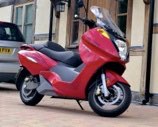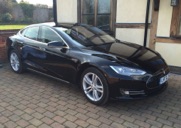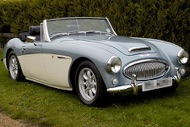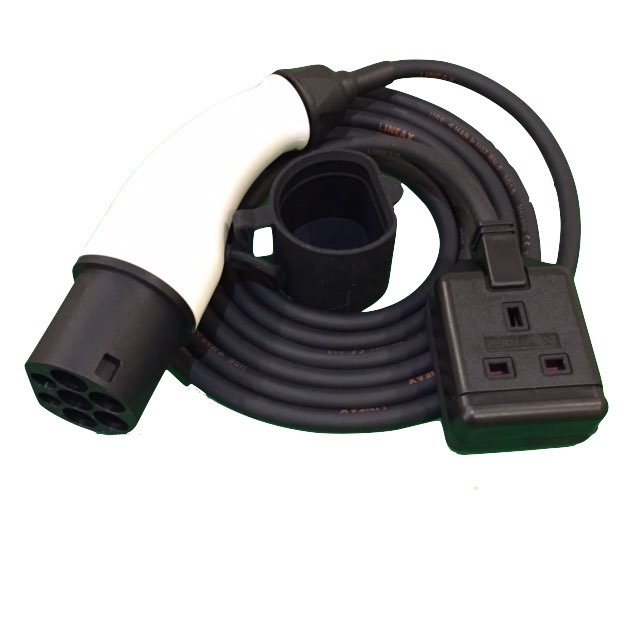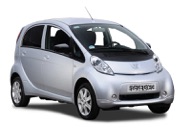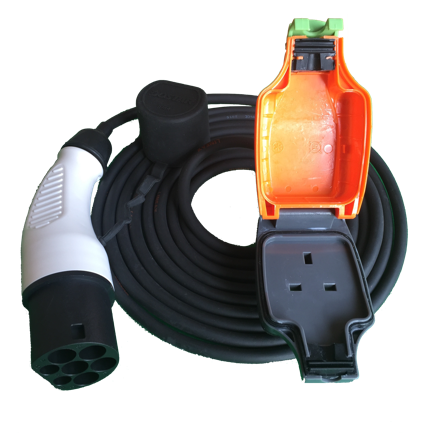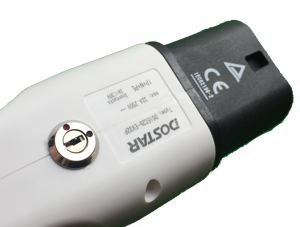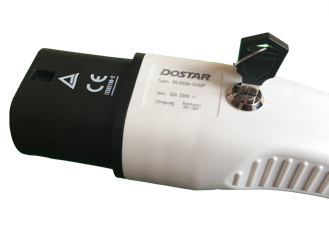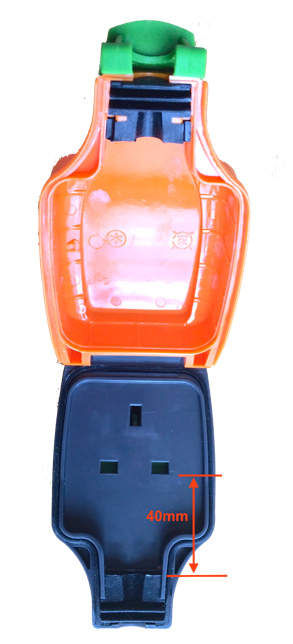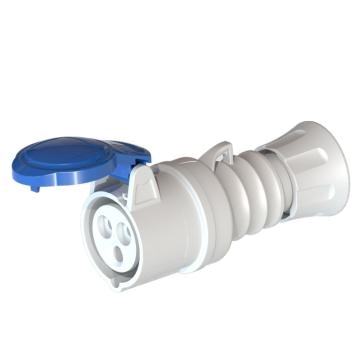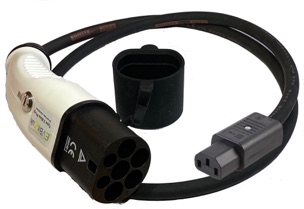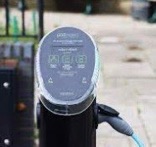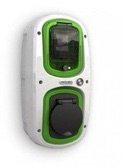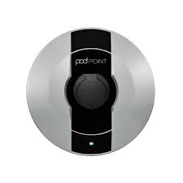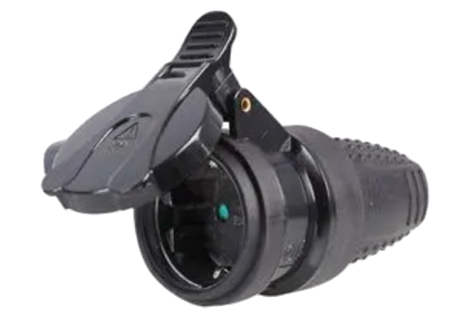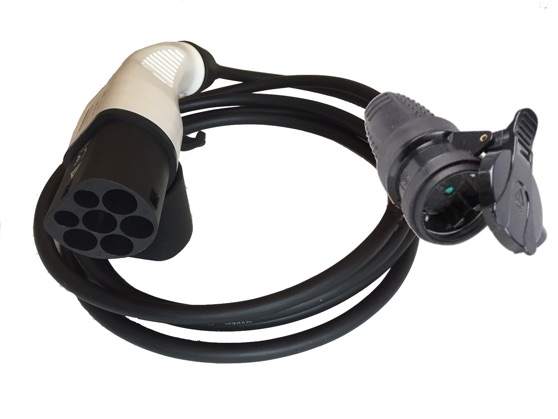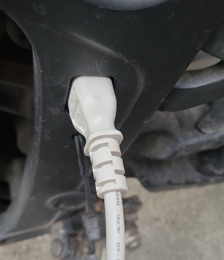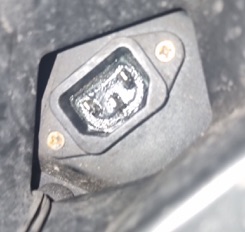Non-EV Use: The standard adaptors can also be used to power anything that has a mains (UK 13A, Schuko 16A or CEE/Commando as applicable to the adaptor version) plug on it including ordinary domestic appliances, eg, hoovers, pressure washers, lawn mowers, 12V car battery trickle chargers/maintainers, portable mains supplies, etc.
The standard cable length for all adaptors other than ADP5, 32A CEE version is 2.6m in tuff, flexible, 2.5mm2, H07-RNF (rubber) cable, rated at 23A continuous for all versions except for the ADP5 which uses 6mm2 EV flex, rated at 50A continuous and whose standard length is 1m but is also available 5m long. Note that these current ratings are only included here to indicate that the adaptor cable specification significantly outperforms the current they will be required to carry in operation (see more on this later).
A 5m option for all adaptors is also available. If you want a longer or shorter cable please ask. 10m is the maximum, 0.3m the minimum (the former will be more expensive depending on which version is ordered but the latter will be the same price as the standard option).
These adaptors will handle up to a maximum of 32A (depending on type of adaptor ordered). However, ultimately, the maximum power available to charge your EV will be dictated by your EV's on-board charger - but no standard EV will have a 13A plug if it is capable of drawing more than 10A because 10A is the maximum current you can draw from a standard UK 13A 3-pin socket *continuously* for hour upon hour without a danger of over-heating the socket/plug connection.
All versions except ADP5 will instruct the EVSE to limit the charging current to 20A, maximum; ADP5 has a 32A maximum current limit. Again, note that these are *maximums*; the connected appliance will only draw what current it requires and as long as that is less than these maximums, there will not be an issue. Simply connecting an appliance to a supply that is capable of supplying greater current than the appliance uses will not ‘force’ more current into the appliance!
Whilst charging, the standard adaptor's Type 2 plug is normally locked into the EVSE but the 3-pin mains plug is not, nor is the adaptor's mains socket water-proof (although the ‘MasterPlug’ socket option is ‘weather-proof’) so it should be ideally secured somewhere safe (eg locked in the boot/storage - to prevent unauthorized disconnection) and dry when in use.
5 different standard sockets are offered: standard 13A, MasterPlug 13A (IP54 - ‘dust protected, weather-proof’), EU Schuko and 16A & 32A CEE (blue commando, camping/caravanning, marine) - see photos. Your choice of alternative socket can be requested at potentially extra cost.
How to use the adaptor:
Connection:
1/ Ensure the adaptor’s key switch is in the 'on' position (12 o’clock position/green dot).
2/ Connect the EV’s charging plug into the adaptor’s trailing socket.
3/ Insert the adaptor’s Type 2 plug into the EVSE socket (using RFID card or smartphone app to unlock it, etc, as required).
4/ RFID/smartphone-based EVSEs usually start automatically after a few seconds (or follow the EVSE’s network app or EVSE instructions) and EVSE status light will change colour indicating 'charging'.
Disconnection:
1/ Stop the charge (if it has not done so already automatically) by using the EV's controls. Do NOT disconnect the EV's plug from the adaptor's socket until the EV has stopped charging.
2/ If RFID/app-type EVSE: Use the app or RFID card to stop the charging. The Type 2 plug will be unlocked after a short delay.
3/ If 'manual' EVSE: Switch off the EVSE. This should unlock the Type 2 plug. If there is no switch, then operate the Type 2 key switch until the Type 2 plug is unlocked. Turn the switch back to the 'on' position ready for next use - and remove key!
Note: If your Type 2 plug will not release, first try pushing the Type 2 plug *into* the socket before pulling it out as the locking mechanism pin is prone to sticking and pushing the Type 2 plug in releases it. If this fails and the Type 2 plug is still stuck in the EVSE’s socket, you must isolate the EVSE by contacting its operator or owner and arranging for them to turn off the EVSE at the mains, nearby isolator or consumer unit (fuse box). In the event of a mains failure, normally the Type 2 plug will automatically be released.
Key Switch: Generally, you should not use the adaptor’s key switch with EVSEs as it can ‘confuse’ the EVSE. Most EVSEs that use a smartphone app will unlock the plug in the normal course of charging i.e. either when the EV has finished charging or when you command the EVSE to stop charging via the smartphone app or by presenting the network’s RFID card.
e-bikes: The adaptors will also work to charge any e-bike from any socketed EV chargepoint (assuming you have the e-bike charger with you and it is fitted with a mains plug).
Zero Motorcycle Users:- A variant can be ordered terminating in a C13 plug to replace the standard charging lead to permit charging the older non-Type 2 socket-equipped Zeros (which have a matching ‘C14’ charging socket - see pics below) from a standard ‘free-cable’ (ie non-tethered) charging point. Please order the ADP13 (and extra length, if needed). This is available in either single or dual formats (see single version photo below).
Please note that some early Zeros have a ‘tight’ C14 socket that has reduced clearance between the bikes frame and the C14 socket for the bulky part of the C13 plug and therefore the standard C13 plug will not fully plug into the bike’s socket (see photo below - far right). These bikes require the ‘ADP13-S’ adaptor which uses a special moulded-on plug which is slightly smaller than the standard C13 plug. This version will also fit the ‘standard’ Zero C14 socket but is more expensive. Note that the ‘ADP13-S’ adaptor cable is available only at 3m long, maximum and uses 1.5mm2 PVC covered flex. If you want it shorter, let me know on ordering.
Twizy Users:- The standard UK Twizy plug has a rather large 13A mains plug strain relief moulding which interferes with the proper closing of the MasterPlug version (only) socket lid. You can remove 2 segments of the strain relief (as shown here...) using either a craft knife or snippers which will allow the lid to close easily. Some customers have advised that the actual Twizy cable diameter is too large for the seal in the ADP2 socket. f you find this is the case I can only suggest that you carefully (to avoid damaging the socket) ream out the seal (with the lid closed) with a suitably sized drill. The standard Twizy plug will fit the Standard socket without modification.
Zappi EVSE Users:-
Apparently, the Zappi has a setting which can be removed that delays a charge by 10 minutes after connecting the EV. If your adaptor does not immediately turn on the Zappi when connected with the adaptor’s key-switch in the ‘on’ (green dot/12 o’clock) position, please check this setting is set to ‘off’.
RV, Camper-van and Boat Users:-
These adaptors may also be used to charge large internal batteries in RVs, camper-vans and similar vehicles which typically have an externally mounted CEE (aka ‘blue commando’) socket usually rated at 16A (for ID purposes, these have an internal socket diameter of 44mm, 32A ones are 59mm) and which are normally used to plug into a convenient mains supply eg those provided at camping grounds, etc. This is very similar to the idea of ‘shore power’ in the marine context where a boat moored at a pontoon would connect to the supply provided for this purpose to provide mains power to the boat whilst moored up. Indeed, the ‘ADP’ range of adaptors could also be used in precisely this way for boats moored at locations which have EV charging facilities using the standard Type 2 socket (and tethered female Type 2 plugs) that are starting to appear.
Citroën Ami Users:-
To use your Ami’s standard charging cable with either a tethered Type 2 EVSE (chargepoint) or on the EV end of a standard Type 2 to Type 2 cable plugged into a standard Type 2 socketed EVSE, then you must also buy the ‘Short T2MP’ option. This a special version of the Type 2 male plug that properly connects to the female Type 2 plug on the end of the tethered EVSE cable.
Technical Notes for DIY-built EVs:-
All the adaptors on this page are designed to communicate their maximum current-carrying capability to the chargepoint (EVSE) once connected. In the case of UK and 16A CEE plug adaptor versions, this maximum current ‘agreement’ is set at 20A. In the case of the 32A CEE version it is 32A.
However, neither the EVSE nor the adaptor cable can control the maximum current that the EV’s charger will draw once connected. Therefore, for any EV which uses any sort of ‘unofficial’ ie non-OEM charging system (eg a DIY arrangement), it is essential that the EV’s charging system design accounts for the maximum current it will draw from the EVSE. Otherwise, at best the EVSE will go into fault mode and disconnect the EV and, at worst, the adaptor could dangerously overheat.
All standard EVs which were originally sold with tethered charging leads terminated with a standard domestic plug (of any country) will never draw more current than that standard plug was designed for. Thus, EVs with UK 13A 3 pin plugs (BS1363) fitted will (should!) not draw more than 10A, those with 16A CEE plugs or European ‘Schuko’ plugs will not draw more than 15/16A and EVs with 32A charging leads will not draw more than 32A.
Tethered EVSEs:-
Without modification, EVSEs with a tethered Type 2 female connector will not work with the standard ADP adaptors due to a deliberate plug design facet intended to specifically stop people from extending tethered cables with ‘free’ Type 2 to Type 2 cables designed for non-tethered chargepoints. This includes ‘dual or triple-header’ ‘rapid’ charge-points including CCS types. If you want compatibility with these charge-points too (AC only) you must add the ‘Short T2MP’ option to whatever adaptor cable you need. Note that adaptors which have the ‘short T2MP’ option will not have a key-switch fitted because the switch is irrelevant due to the shorter T2MP being unable to lock into a standard ‘free-cable’ (ie socketed) charge-point. The only difference between the standard Type 2 male plug and the short version is .... that the short version’s ‘nose’ (the black bit with the pins in it) is 12mm shorter... so please don’t ask for a picture of it!
